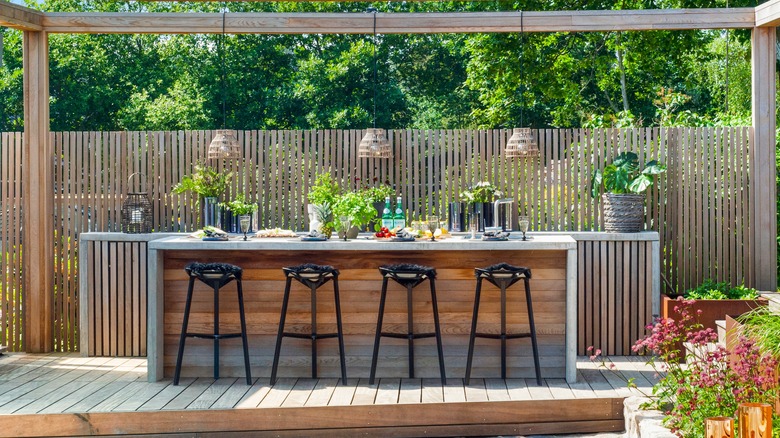Why TikTok's Repurposed Pallet Outdoor Kitchen Design Is Too Good To Be True
The market for luxury outdoor kitchens is on the rise — more than two-thirds of homeowners are willing to spend more than $5,000 on this sort of open-air entertainment area. Of course, there's a potential way to sidestep that expense and still come away with a beautiful outdoor kitchen thanks to some TikTok tutorials. But be wary of projects that look too good to be true, because they probably are. One TikTok in particular promotes using repurposed wood pallets to build a stunning DIY outdoor kitchen with lots of perks, but it fails to address several flaws and safety concerns.
The projected final kitchen comes complete with a sink, cool containment area, and barbecue zone. While many of these ideas are innovative and appealing, several commenters point out the potential safety hazards of the materials used. The original poster answers these concerns by saying that this demonstration is a prototype, meant to be customized and improved upon as anyone undertaking the project sees fit. In other words, this project cannot be safely endorsed, and while you may gain inspiration from it, it's best to research the safest ways to incorporate those ideas within a similar design.
A problematic barbecue station
When building a barbecue pit for your outdoor kitchen, you must insulate the ground and any surrounding structures from the fire. Masonry experience is a plus and requires several supplies above and beyond what you might have as a general homeowner. At a minimum, you should lay a concrete footer and several courses (layers) of bricks. As a last touch, the grill pan and grate should be food-safe stainless steel or cast iron to properly conduct heat.
This TikTok barbecue station created by user @vilda143 doesn't follow these guidelines. The video does emphasize using refractory bricks for the station, which do not get as hot as standard bricks. However, in part one, they lay the bricks directly on a pallet structure. Given the construction leading up to this point, it's not entirely clear how that pallet base gets there, but it's definitely not cut out to hold the weight of three courses of bricks. Furthermore, part two shows a plastic-coated metal basket repurposed as a grill grate and cemented in place. The plastic will melt, and cementing the grate down will make it difficult to clean or access the fire below. Finally, part three shows the users placing wood directly onto a brick from a small access hole on the side, in close contact with the pallet wood with insufficient ventilation.
A note on food safety
If you're going to use pallets for a project they need to be sturdy, but for food prep surfaces they also need to be food-safe, and pallets fail here. Whether you've obtained permission to sort through store discards or purchased pallet lots from local recycling services, you need to check them for structural integrity because pallet wood is often warped or rickety. However, the bigger problem with pallets is that you don't know what, if any, chemicals the boards have come into contact with. As much as you want boards that are solidly constructed, you also want to pay attention to any stamps on the boards. "HT," for example, means heat-treated, indicating the wood was processed to resist pests and fungus. "MB," meanwhile, stands for methyl bromide and means the pallet was treated with the chemical compound as a pesticide.
Pallets can be treated with several different chemicals, and not knowing what they might be makes it too risky to use pallet wood for your food preparation surfaces. Yes, wood can be treated with food-safe epoxy resins so they are an acceptable prep surface, and if they're carefully and properly applied these chemicals are very effective. But if your boards have been exposed to unidentified chemicals, the epoxy might not act as a barrier. Moreover, many of these resins are not meant to be used near heat, and they shouldn't be used on wooden cutting surfaces, further disqualifying them as an option for your kitchen project.
